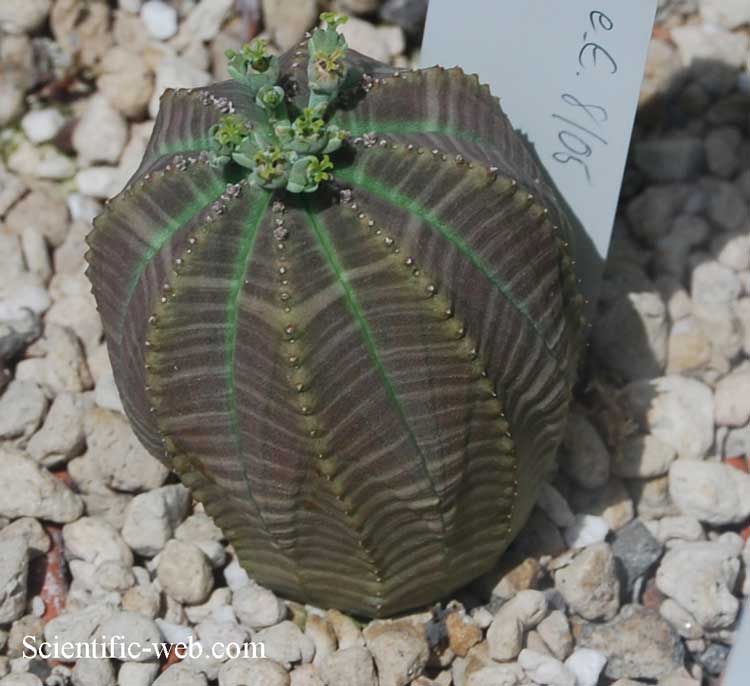
Euphorbia obesa, Photo: Michael Lahanas
Classification System: APG IV
Superregnum: Eukaryota
Regnum: Plantae
Cladus: Angiosperms
Cladus: Eudicots
Cladus: Core eudicots
Cladus: Rosids
Cladus: Eurosids I
Ordo: Malpighiales
Familia: Euphorbiaceae
Subfamilia: Euphorbioideae
Tribus: Euphorbieae
Subtribus: Euphorbiinae
Genus: Euphorbia
Subgenus: E. subg. Athymalus
Sectio: E. sect. Anthacanthae
Subsectio: E. subsect. Florispinae
Series: E. ser. Meleuphorbia
Species: Euphorbia obesa
Name
Euphorbia obesa Hook.f. 1903
Synonyms
Heterotypic
Euphorbia cucumerina Willd., Sp. Pl., ed. 4, 2: 886 (1799), provisionally listed as a synonym.
Euphorbia symmetrica A.C.White, R.A.Dyer & B.Sloane, Succ. Euphorb.: 963 (1941).
Euphorbia obesa subsp. symmetrica (A.C.White, R.A.Dyer & B.Sloane) G.D.Rowley, Euphorbiaceae Study Group Bull. 11(3): 97 (1998).
Distribution
Native distribution areas:
Continental: Africa
Regional: Southern Africa
Cape Prov.
References: Brummitt, R.K. 2001. TDWG – World Geographical Scheme for Recording Plant Distributions, 2nd Edition
References
Primary references
Hooker, J.D. 1903. Curtis’s botanical magazine, comprising the plants of the Royal Gardens of Kew, and of other botanical establishments in Great Britain; with suitable descriptions. Vol. 129 [= Vol. 59 of the third series.] pp. 7872–7931. Lovell Reeve, London. BHL Reference page. : 129: t. 7888.
Links
Govaerts, R. et al. 2020. Euphorbia obesa in World Checklist of Selected Plant Families. The Board of Trustees of the Royal Botanic Gardens, Kew. Published on the internet. Accessed: 2020 Jul 05. Reference page.
International Plant Names Index. 2020. Euphorbia obesa. Published online. Accessed: Jul 05 2020.
Govaerts, R. et al. 2020. Euphorbia obesa in Kew Science Plants of the World online. The Board of Trustees of the Royal Botanic Gardens, Kew. Published on the internet. Accessed: 2020 Jul 05. Reference page.
Tropicos.org 2020. Euphorbia obesa. Missouri Botanical Garden. Published on the internet. Accessed: 2020 Jul 05.
USDA, ARS, Germplasm Resources Information Network. Euphorbia obesa in the Germplasm Resources Information Network (GRIN), U.S. Department of Agriculture Agricultural Research Service. Accessed: 08-Apr-12.
Vernacular names
English: Baseball Plant
polski: Wilczomlecz opasły
русский: Молочай тучный
svenska: Kloteuforbia
українська: Молочай товстий
中文: 晃玉
Euphorbia obesa is a subtropical succulent species of flowering plant in the genus Euphorbia. It comes from South Africa, especially the Cape Province. Sometimes referred to as the baseball plant.
In the wild it is endangered because of over-collection and poaching, combined with its slow growth, and the fact that the pod contains only 2 to 3 seeds. However, it is widely cultivated in botanical gardens.
Description
Euphorbia obesa resembles a ball, thornless and decorative. It is commonly known as 'baseball plant' due to its shape. Its diameter is between 6 cm and 15 cm depending on its age. Young plants are spherical, but become cylindrical with age. They contain water reservoirs for periods of drought.
It almost always shows 8 ridges adorned with small deep gibbosity regularly planted on the edges. It is green with horizontal lighter or darker stripes. In the wild, and with exposure to direct sunlight, it shows red and purple areas.
The plant is dioecious, which means that a subject has only male or female flowers. The small flowers are insignificant in apex. In fact, like all Euphorbia, flowers are called cyathia.
As in all Euphorbia species, the latex is toxic.[1]
Living in similar conditions on two different continents, Euphorbia obesa presents a form of convergence with Astrophytum asterias which is a cactus from Mexico.
Distribution
This species is indigenous to a small range in the arid Karoo region of South Africa. This is a region of summer rainfall.[2]
Cultivation
In cultivation in the UK, Euphorbia obesa has won the Royal Horticultural Society's Award of Garden Merit.[3]
Euphorbia obesa is a subtropical succulent species of flowering plant in the genus Euphorbia. It comes from South Africa, especially the Cape Province. Sometimes referred to as the baseball plant.
In the wild it is endangered because of over-collection and poaching, combined with its slow growth, and the fact that the pod contains only 2 to 3 seeds. However, it is widely cultivated in botanical gardens.
Description
Euphorbia obesa resembles a ball, thornless and decorative. It is commonly known as 'baseball plant' due to its shape. Its diameter is between 6 cm and 15 cm depending on its age. Young plants are spherical, but become cylindrical with age. They contain water reservoirs for periods of drought.
It almost always shows 8 ridges adorned with small deep gibbosity regularly planted on the edges. It is green with horizontal lighter or darker stripes. In the wild, and with exposure to direct sunlight, it shows red and purple areas.
The plant is dioecious, which means that a subject has only male or female flowers. The small flowers are insignificant in apex. In fact, like all Euphorbia, flowers are called cyathia.
As in all Euphorbia species, the latex is toxic.[1]
Living in similar conditions on two different continents, Euphorbia obesa presents a form of convergence with Astrophytum asterias which is a cactus from Mexico.
Distribution
This species is indigenous to a small range in the arid Karoo region of South Africa. This is a region of summer rainfall.[2]
Cultivation
In cultivation in the UK, Euphorbia obesa has won the Royal Horticultural Society's Award of Garden Merit.[3]
Retrieved from "http://en.wikipedia.org/"
All text is available under the terms of the GNU Free Documentation License

